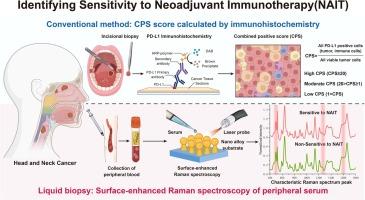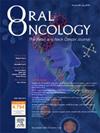Noninvasive surface-enhanced Raman spectroscopy outperforms combined positive score in predicting sensitivity to neoadjuvant immunotherapy in head and neck squamous cell carcinoma
IF 4
2区 医学
Q1 DENTISTRY, ORAL SURGERY & MEDICINE
引用次数: 0
Abstract
Background
Head and neck squamous cell carcinoma poses a formidable treatment challenge owing to its complex anatomy and essential functions of the organs involved. Neoadjuvant immunotherapies, particularly PD-1 inhibitors, have shown promise in improving patient outcomes. Nevertheless, the ability to accurately predict which patients will benefit from neoadjuvant immunotherapy continues to be a significant hurdle.
Methods
We investigated 46 patients diagnosed with head and neck squamous cell carcinoma. Combined positive score was assessed before treatment. Serum samples were collected both before and after neoadjuvant immunotherapy, and subsequently analyzed utilizing surface-enhanced Raman spectroscopy.
Results
Significant differences in Raman spectral peaks were observed between the partial response and stable disease groups before treatment, particularly in the regions of 516–525 cm−1, 1240–1400 cm−1, 1600–1636 cm−1, and 1647–1680 cm−1. These peaks represent different cancer-related biochemical components, including protein and nucleic acid vibrations, disulfide bonds, amide III bands, CH2/CH3 deformations, and amide I bands. Principal Component Analysis-Linear Discriminant Analysis and Receiver Operating Characteristic analysis demonstrated that surface-enhanced Raman spectroscopy exhibited remarkable sensitivity and specificity, surpassing the combined positive score in assessing patient responses to neoadjuvant immunotherapy.
Conclusion
Surface-enhanced Raman spectroscopy offers significant potential to surpass the conventional combined positive score in predicting responses to neoadjuvant immunotherapy.

在预测头颈部鳞状细胞癌对新辅助免疫疗法的敏感性方面,无创表面增强拉曼光谱优于综合阳性评分。
背景:头颈部鳞状细胞癌由于其复杂的解剖结构和相关器官的重要功能,给治疗带来了巨大挑战。新辅助免疫疗法,尤其是 PD-1 抑制剂,已显示出改善患者预后的前景。然而,准确预测哪些患者将从新辅助免疫疗法中获益仍然是一个重大障碍:方法:我们调查了 46 名确诊为头颈部鳞状细胞癌的患者。治疗前对综合阳性评分进行评估。在新辅助免疫疗法前后采集血清样本,随后利用表面增强拉曼光谱进行分析:结果:部分反应组和病情稳定组在治疗前的拉曼光谱峰值存在显著差异,尤其是在 516-525 cm-1、1240-1400 cm-1、1600-1636 cm-1 和 1647-1680 cm-1 区域。这些峰代表不同的癌症相关生化成分,包括蛋白质和核酸振动、二硫键、酰胺 III 带、CH2/CH3 变形和酰胺 I 带。主成分分析-线性判别分析和接收者操作特征分析表明,表面增强拉曼光谱在评估患者对新辅助免疫疗法的反应方面具有显著的灵敏度和特异性,超过了综合阳性评分:结论:表面增强拉曼光谱在预测新辅助免疫疗法反应方面具有超越传统综合阳性评分的巨大潜力。
本文章由计算机程序翻译,如有差异,请以英文原文为准。
求助全文
约1分钟内获得全文
求助全文
来源期刊

Oral oncology
医学-牙科与口腔外科
CiteScore
8.70
自引率
10.40%
发文量
505
审稿时长
20 days
期刊介绍:
Oral Oncology is an international interdisciplinary journal which publishes high quality original research, clinical trials and review articles, editorials, and commentaries relating to the etiopathogenesis, epidemiology, prevention, clinical features, diagnosis, treatment and management of patients with neoplasms in the head and neck.
Oral Oncology is of interest to head and neck surgeons, radiation and medical oncologists, maxillo-facial surgeons, oto-rhino-laryngologists, plastic surgeons, pathologists, scientists, oral medical specialists, special care dentists, dental care professionals, general dental practitioners, public health physicians, palliative care physicians, nurses, radiologists, radiographers, dieticians, occupational therapists, speech and language therapists, nutritionists, clinical and health psychologists and counselors, professionals in end of life care, as well as others interested in these fields.
 求助内容:
求助内容: 应助结果提醒方式:
应助结果提醒方式:


